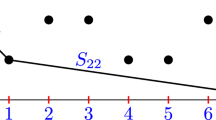Abstract
The triplet (a, b, c) of positive integers is said to be compositum-feasible if there exist number fields K and L of degrees a and b, respectively, such that the degree of their compositum KL equals c. We determine all compositum-feasible triplets (a, b, c) satisfying a ≤ b and b ∈ {8, 9}. This extends the classification of compositum-feasible triplets started by Drungilas, Dubickas, and Smyth [5]. Moreover, we obtain several results related to triplets of the form (a, a, c). In particular, we prove that the triplet (n, n, n(n − 2)) is not compositum-feasible, provided that n ≥ 5 is an odd integer.
Similar content being viewed by others
References
G. Baron, M. Drmota, and M. Skałba, Polynomial relations between polynomial roots, J. Algebra, 177(3):827–846, 1995.
J.D. Dixon and B. Mortimer, Permutation Groups, Grad. Texts Math, Vol. 163, Springer, New York, 1996.
P. Drungilas and A. Dubickas, On degrees of three algebraic numbers with zero sum or unit product, Colloq. Math., 143(2):159–167, 2016.
P. Drungilas, A. Dubickas, and F. Luca, On the degree of the compositum of two number fields, Math. Nachr., 286(2–3):171–180, 2013.
P. Drungilas, A. Dubickas, and C.J. Smyth, A degree problem of two algebraic numbers and their sum, Publ. Math., 56(2):413–448, 2012.
I.M. Isaacs, Degrees of sums in a separable field extension, Proc. Am. Math. Soc., 25:638–641, 1970.
C.U. Jensen, A. Ledet, and N. Yui, Generic Polynomials. Constructive Aspects of the Inverse Galois Problem, Cambridge Univ. Press, Cambridge, 2002.
S. Lang, Algebra, 3rd revised ed., Grad. Texts Math., Vol. 211, Springer, New York, 2002.
A.R. Perlis, Roots appear in quanta, Am. Math. Monthly, 111(1):61–63, 2004.
C.J. Smyth, Additive and multiplicative relations connecting conjugate algebraic numbers, J. Number Theory, 23:243–254, 1986.
I. Stewart, Galois Theory, 4th ed., Chapman & Hall/CRC, Boca Raton, FL, 2015.
Author information
Authors and Affiliations
Corresponding author
Additional information
Dedicated to Professors Antanas Laurinčikas and Eugenijus Manstavičius on the occasion of their 70th birthdays
Publisher’s note
Springer Nature remains neutral with regard to jurisdictional claims in published maps and institutional affiliations.
* This research was funded by a grant (No. S-MIP-17-66/LSS-110000-1274) from the Research Council of Lithuania.
Rights and permissions
About this article
Cite this article
Drungilas, P., Maciulevičius, L. A degree problem for the compositum of two number fields*. Lith Math J 59, 39–47 (2019). https://doi.org/10.1007/s10986-019-09428-x
Received:
Revised:
Published:
Issue Date:
DOI: https://doi.org/10.1007/s10986-019-09428-x



